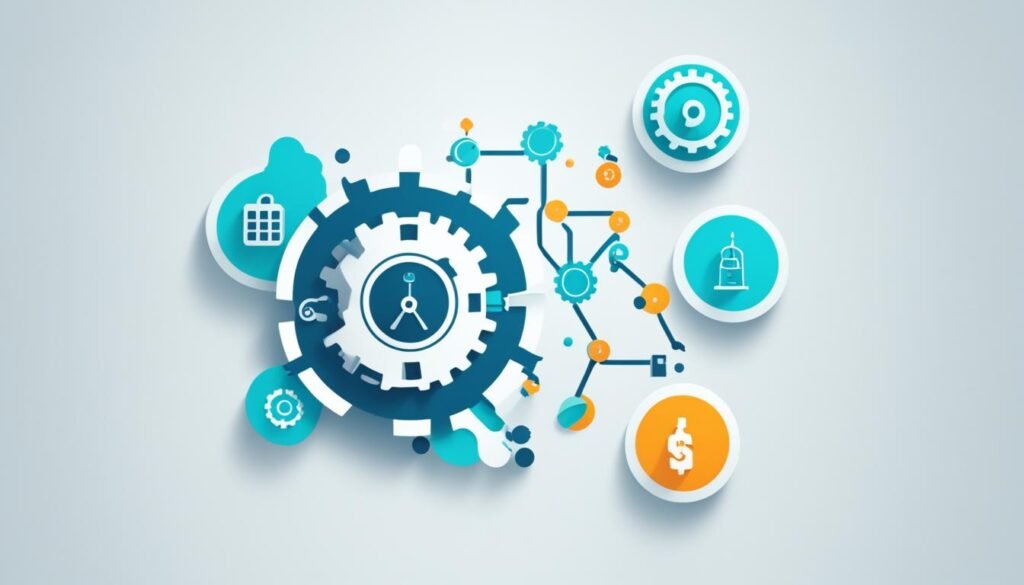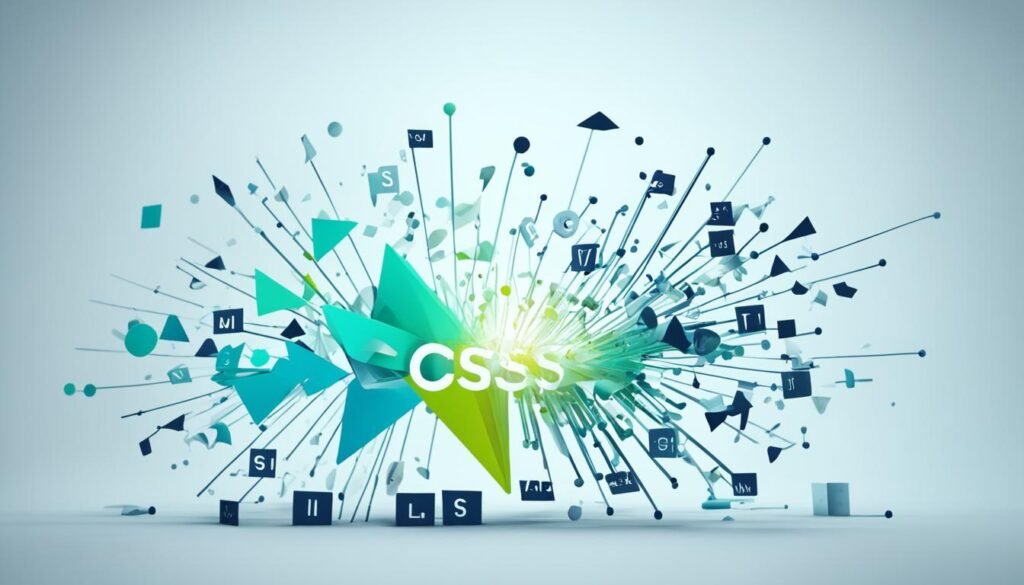Starting a business is thrilling, but it takes more than just passion and effort. You need a strong foundation and a clear plan. This plan shows how your business will make, deliver, and capture value. The Business Model Canvas (BMC) is a tool that helps entrepreneurs plan and improve their business on one page. This guide will show you how to make your own Business Model Canvas.
Table of Contents
Understanding the Business Model Canvas
The Business Model Canvas (BMC) is a tool for strategic management. It has nine key parts for a successful business. This framework helps entrepreneurs clearly define and share their business or product’s core elements. It connects ideas to building a successful business.
What is a Business Model Canvas?
The Business Model Canvas is a one-page tool that lists the main parts of a business. These include Customer Segments, Value Propositions, Channels, Customer Relationships, Revenue Streams, Key Resources, Key Activities, Key Partnerships, and Cost Structure. By looking at these nine parts, businesses can understand and make smart choices for growth and innovation.
The Nine Building Blocks of the Business Model Canvas
- Customer Segments: Identifying the groups of people or organizations a business aims to reach and serve.
- Value Propositions: Defining the unique products or services that create value for specific customer segments.
- Channels: Determining the ways a business talks to and delivers value to customers.
- Customer Relationships: Setting the types of relationships a business wants with its customers.
- Revenue Streams: Finding the ways a business makes money from its customers.
- Key Resources: Identifying the essential assets needed for the business model.
- Key Activities: Figuring out the critical actions a business must take to work well.
- Key Partnerships: Finding the strategic alliances and collaborations that support the business model.
- Cost Structure: Listing the biggest costs of running the business model.
By focusing on and improving each of these nine areas, businesses can build a detailed and flexible model. This model helps guide their growth and decision-making.
“The Business Model Canvas provides a comprehensive and flexible framework for understanding, designing, and innovating business models.” – Alex Osterwalder, co-creator of the Business Model Canvas
Start with Customer Segments
Understanding your target customers is key to a successful business. By doing thorough market research and customer segmentation, you learn a lot about who you want to serve.
Customer segmentation means dividing your potential customers into groups with similar traits, likes, and actions. This helps you make your value propositions, marketing, and products fit each group’s needs and wants.
| Business Model | Customer Segmentation Approach |
|---|---|
| Mass Market | No customer segmentation, targeting a large, undifferentiated population |
| Niche Market | Highly personalized products or services for a smaller, specific customer segment |
| Segmented | Offering variations of products/services for distinct customer segments |
| Diversified | Serving customers with completely different needs and requirements |
| Multilateral Platform | Targeting two or more interdependent customer segments |
Knowing what customers struggle with, their budget, and the size of their market helps you segment your target market. You can then make solutions that speak to each group. This way of customer segmentation is key to a successful, customer-focused business.

This image from freepik
Define Your Value Propositions
After finding out who your customers are, it’s time to explain what makes your business special. Your value proposition should clearly show how your product or service helps solve a problem or makes things better for your customers. It’s key to make sure your value propositions really tackle the issues your customers face and stand out from others.
Solve Real Problems
A good value proposition does more than just list what you offer. It zeroes in on the specific needs and problems of your target customers. By really getting to know what your customers struggle with, you can create solutions that really speak to them.
Differentiate from Competitors
With so many choices out there, it’s vital to show what makes your business unique. Look at what your competitors say they offer and find what makes your stuff better. This could be about price, quality, ease of use, or something else that your customers like.
| Metric | Value |
|---|---|
| Percentage of businesses that develop a clear value proposition to attract customers | 78% |
| Ratio of businesses that focus on customer problems in their value proposition instead of just their products or services | 3:1 |
| Percentage of companies successful in defining their unique offers in their value propositions | 65% |
Creating a strong value proposition that meets your customers’ needs and makes you stand out can really help your business succeed.
“A carefully crafted value proposition is complex and detailed. It should be specific and tailored to meet the individual needs of a particular customer rather than being broad and generic to appeal to a wide audience.”
Outline Your Channels
Finding the best ways to connect with your customer segments is key to your business plan. You can sell directly, like on your own website, or indirectly through distribution channels and marketing channels. This choice affects how you reach and share your value proposition with customers.
Think about what your customer segments like and do. Pick channels they use most to interact with and get your value proposition. Use a mix of online and offline ways to make sure your customer experience is smooth across all customer touchpoints.
Choose the Right Channels
Choosing the best channels means looking at a few things:
- Know your customer segments and their favorite channels for finding, checking out, and buying
- Look at how different distribution channels and marketing channels work in terms of cost and efficiency
- See how much control and interaction each channel lets you have with customers
- Find out if different customer touchpoints work well together
- Keep testing and adjusting your channel mix to hit your target audience best
Picking and blending the right channels helps you share your value proposition well. It also makes sure your customer experience is smooth, helping you grow your customer base.
| Channel Type | Examples | Advantages | Disadvantages |
|---|---|---|---|
| Direct Channels |
|
|
|
| Indirect Channels |
|
|
|
By picking the right mix of direct and indirect channels, you can make a strong distribution strategy. This strategy will effectively reach and engage your target customer segments.

This image from freepik
Establish Customer Relationships
Building strong customer relationships is key for any business to succeed. You can choose to have transactional interactions or aim for deeper, long-term connections. The kind of relationship you build affects your customer experience, customer retention, and customer loyalty.
One way to connect with customers is through personal assistance. You can assign specific people to help with questions and support. For top clients, you might give them dedicated personal assistance for a unique experience. Or, you could use self-service options or automated services for customized help.
Creating a community around your brand is another strong strategy. It helps you connect deeply with customers and get valuable feedback. This can include working together with customers on product design or reviews.
It’s important to think about how easy it is for customers to switch to a competitor. If it’s easy, you need to make sure your customer experience is always top-notch. This keeps your customers coming back and loyal to your brand.
| Relationship Type | Description | Advantages | Disadvantages |
|---|---|---|---|
| Transactional | Limited interactions for specific transactions | Efficient, scalable | Lack of depth, one-time relationships |
| Long-term | Deeper connections, fostering loyalty and trust | Increased loyalty, more repeat business | Require more investment and effort |
| Personal Assistance | Assigning specific customer representatives | Personalized support, stronger relationships | Higher operating costs |
| Dedicated Personal Assistance | Exclusive services for high-value clients | Highly personalized, premium experience | Limited scalability, higher costs |
| Self-Service | Customers meet their needs autonomously | Cost-effective, convenient for customers | Lack of personal interaction |
| Automated Services | Fully automated processes with human involvement | Efficient, consistent, customizable | Potential lack of personal touch |
| Communities | Community-based interactions, fostering meaningful connections | Increased engagement, valuable customer insights | Requires ongoing community management |
Think about the kind of customer relationships you want to build. A well-thought-out approach can improve the customer experience and increase customer loyalty and customer retention for your business.
Identify Revenue Streams
As a business owner, making sure you have steady income sources is key. Your choice of revenue models and pricing will affect how your company makes money and stays profitable. It’s important to have different ways of making money to lower risks and keep your business going strong over time.
Diversify Your Income
Successful companies often use many ways to make money to grow and stay stable. Think about using different revenue models like one-time sales, subscriptions, leasing, or ads. This mix helps keep money coming in regularly and lessens dependence on just one way of making money.
Amazon makes money not just from selling things online but also from cloud services and ads. Google gets most of its income from ads on its search engine and YouTube. Apple is known for its gadgets but also earns from services like the App Store, Apple Music, and iCloud.
Test Pricing Models
Finding the right price for your products or services is key to making money and pleasing your customers. Try out different pricing methods, like one-time sales, subscriptions, or pay-per-use. You might even mix these together.
Companies like Netflix and Disney do well with subscription models, which give them steady money every month. Microsoft makes money from a wide range of products and services, including software, cloud services, games, and search ads.
| Company | Primary Revenue Streams | Revenue Figures (FY 2023) |
|---|---|---|
| Walmart | In-store sales, eCommerce, membership fees | $611.3 billion |
| Apple | Device sales, subscriptions, app commissions, payment service fees | $383.933 billion |
| Tesla | Electric vehicle sales, energy generation, auto leasing, regulatory credits | $94.02 billion |
| TripAdvisor | Advertising, subscription fees, commission and booking fees | $1.67 billion |
By trying out different revenue models and pricing, you can make your business more profitable and set it up for success over time.
Determine Key Resources
When building your business model, it’s key to know what resources you need. These can be things like equipment, knowledge, people, or money. Make sure you have these resources ready to help your business succeed.
Prioritize Resources
First, make a list of what your business must have. Think about these things:
- Physical resources: like tools, places to work, materials, and ways to get products to customers
- Intellectual resources: like special patents, copyrights, customer info, and brand value
- Human resources: like unique skills, knowledge, and expertise
- Financial resources: like money, investments, and ways to get more money
After you know what you need, decide which ones are most important. Focus on the ones that are critical to your business. Make sure you have these ready to go.
For instance, a tech company might need a strong IT setup, special software, and a team of skilled engineers. On the other hand, a fashion store might need a good location, lots of suppliers, and a team of talented designers.
By looking closely at and prioritizing your main resources, you can make sure your business is strong and ready to do well.
| Business | Key Resources |
|---|---|
| Technology Company | IT infrastructure, proprietary software, skilled engineering team |
| Fashion Retailer | Strategic store location, supplier network, talented design team |
“The most successful companies are those that are able to effectively manage and leverage their key resources to deliver exceptional value to their customers.”
Define Key Activities
To share your value proposition well, you must pinpoint the key activities your business needs to do. These key business activities might be making products, solving problems, or managing networks, based on your business type. By focusing on these activities, you can make your business run smoother and waste less, which helps improve your business processes.
Streamline Activities
Maximizing your key business activities means making them as efficient as possible. This could mean:
- Optimizing production to cut down on waste and increase what you make
- Using knowledge management systems to use your team’s skills better
- Automating tasks that you do over and over to give your team more time for important tasks
- Improving how teams work together to make things run smoother
- Always checking and making your business processes better to find ways to do things better
By actively working to make your key business activities more efficient, you can boost your operational efficiency. This opens up new chances for growth and innovation.

“The key to success is not the amount of time you spend, but how you spend the time.” – Grant Cardone
Outline Key Partnerships
When planning your business, it’s key to find and grow important partnerships. These partnerships can boost your value and how you work. They help drive your business ahead.
Strategic Alliances
Strategic alliances mean companies work together on projects but stay their own. They can be through franchising, licensing, or affiliate marketing. These partnerships let you enter new markets and use new tech, while sharing risks and costs.
Coopetition partnerships, where rivals work together, are also strategic alliances. For example, Pfizer and BioNTech teamed up on the COVID-19 vaccine.
Mutually Beneficial Relationships
Having strong supplier relationships is key to getting goods or services to your customers. Good relationships with suppliers can save you money and make things more efficient. Joint ventures, where companies work together on projects and share resources, can also be good, but be careful to avoid conflicts.
Key partnerships are crucial for your business’s success. They help you lower risks, find new chances, and boost your value. By carefully building these relationships, you can create a strong business ecosystem. This supports your growth and success over time.
Analyze Your Cost Structure
As an entrepreneur, knowing your business costs is key. You need to understand both fixed costs and variable costs. Fixed costs stay the same, no matter how much you produce or sell. Examples include rent, salaries, insurance, and utilities. Variable costs, however, change with your business activity. This includes things like raw materials, making your products, and shipping them.
To figure out your costs, start by making a list of your main expenses. This will show you where you can cut costs. Using a lean startup method in the beginning helps by cutting unnecessary costs. This way, you can test your business idea without spending too much.
| Fixed Costs | Variable Costs |
|---|---|
|
|
Knowing your business costs helps you make smart choices about pricing, budgeting, and using resources. This makes your business more financially stable.

“Minimizing unnecessary expenses is crucial, especially in the early stages of your business, until you have validated your business model.”
Business Model Canvas
The Business Model Canvas is a tool for entrepreneurs at any stage. It helps you see how your business works and adds value for customers. It’s a simple way to outline your business and plan for success.
This canvas has nine key parts, created by Alexander Osterwalder in 2005. They cover customer segments, value propositions, and more. These elements help build strong business models.
To make your business model canvas example, start by finding your main customers and their problems. Then, think about what makes you different from others. Decide how you’ll talk to your customers and keep them coming back.
Next, figure out how you’ll make money and what you need to do it. Find important partners and check your costs to stay profitable.
| Business Model Canvas Element | Description |
|---|---|
| Customer Segments | Identify key customers and group them based on their pain points, demographics, or buyer behavior. |
| Value Proposition | Determine what makes your business better than competitors to attract leads. |
| Channels | Utilize marketing tools such as social media, paid advertising, and distribution channels to communicate your value proposition. |
| Revenue Streams | Explain primary, secondary, and additional revenue sources such as wholesale, e-commerce, or brick & mortar stores. |
| Customer Relationships | Plan how you will interact with customers from initial contact to after-purchase experience. |
| Key Activities | Identify activities necessary to deliver your value proposition better than competitors. |
| Key Resources | List key personnel, capital, patents, recipes, and other resources crucial for business success. |
| Key Partners | Collaborate with advisors, mentors, organizations, lawyers, and accountants for business success. |
| Cost Structure | Understand your major costs including R&D, capital expenditures, cost of goods sold, fixed costs, and variable costs within your business model. |
Using the business model canvas template helps you see what needs work and covers all important parts. Business model canvas online tools make it easier to work together and adjust to new market trends.
“The Business Model Canvas is a hands-on tool that fosters understanding, discussion, creativity, and analysis.”
Conclusion
The Business Model Canvas is a tool that helps entrepreneurs plan and improve their business strategy on one page. It breaks down into nine key parts. This makes it easy to build a strong base for your business planning and boosts your chances of doing well.
This tool is flexible and useful at all stages of your business, from the start to making ongoing changes. Use it to keep your business model fresh and strong as markets change and new chances come up.
No matter the size or type of your business, the Business Model Canvas offers a clear way to get to know and improve your business strategy. Use this tool to spark innovation, keep everyone in your company on the same page, and help your entrepreneurial dream grow and succeed over time.




I read too many articles but compare to the mini details you provide they were nothing. Keep up the good work.
Greetings, my trusted friend. How have you been keeping lately?
Amazingly, I found this site your pour out a lot of knowledge
Hei, amazing person! I’m excited to discover all that you have to offer.
It may be appealing to you
Until we meet again, and may your spirit soar
I Really like the content specially the startup checklist. Great work Celine.
Your writing style is engaging and informative. I’ve learned so much from this post and can’t wait to apply these tips to my own projects.
Your posts are always so informative.